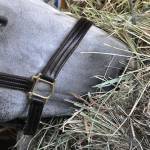Forage Intake for Horses

To accurately calculate the contribution that forage makes to the horse’s overall feeding program, forage intake as well as composition must be known. Hay intake can be determined by simply recording the total weight of hay offered minus any hay wasted or refused. This does not take into account the differences in composition between hay that is offered and that consumed but is accurate enough to do a good evaluation in the field.
Forage requirements are different for various classes of horses based on their body weight. In general, horses need to eat 1 to 2% of their body weight in forage each day. Lactating mares, growing horses, and horses performing extreme exercise may need more forage. Higher forage intakes will occur when there is an abundance of forage available, such as with Kentucky pasture or Washington state alfalfa hay. Lower forage intakes will occur where forage is sparse and of poorer quality such as in the tropics.
Not taking into account the contribution that forage makes to a horse’s overall nutrient intake can result in some serious errors in feeding. At the very least, underestimating a forage’s nutrient contribution will result in unnecessary and expensive supplementation. In extreme cases, this may cause nutrient imbalances or toxicities to occur. At the other extreme, overestimating what a horse gets from its forage will result in nutrient deficiencies. Therefore, it is very important not to ignore the role that forage plays in supplying nutrients to the horse.








